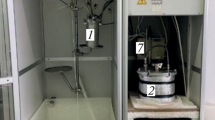Conclusions
The selective properties of hollow fibres used in the separation of solutions of poly-ethylene glycols and proteins have been investigated. It has been shown that the increase in retention coefficient and specific permeability as the velocity of the stream increases, in the separation of solutions of kinetically relatively flexible polyethylene glycol molecules, is not connected with the phenomenon of concentration polarization. but can be explained by the deformability of the tangles of polyethylene glycol macromolecules on flow of the solution in thin capillaries (hollow fibres).
Optimum ultrafiltration conditions have been determined.
Complete retention curves have been constructed for the hollow fibre, which make it possible to determine its region of use.
Similar content being viewed by others
Literature cited
Inventor's certificate 994588 (1983) (USSR).
V. A. Bakunov, A. P. Borshchev, A. M. Golubev, and G. A. Budnitskii, Khim. Volokna, No. 6, 28–29 (1980).
S. T. Hwang and K. Kammermeyer, Membranes in Separation, Wiley (1975).
S. R. Rafikov, S. A. Pavlova, and I. I. Tverdokhlebova, Methods of Determining Molecular Weights and Polydispersity of High-Molecular-Weight Compounds [in Russian], Izd. Akad. Nauk SSSR, Moscow (1963).
Additional information
Translated from Khimicheskie Volokna, No. 6, pp. 14–16, November–December, 1984.
Rights and permissions
About this article
Cite this article
Borshchev, A.P., Zhdanova, N.A., Fedotova, E.A. et al. Selective properties of hollow fibres for ultrafiltration. Fibre Chem 16, 395–398 (1985). https://doi.org/10.1007/BF00546252
Received:
Issue Date:
DOI: https://doi.org/10.1007/BF00546252



